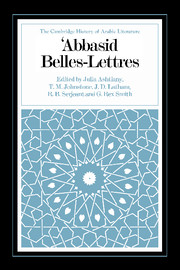Book contents
- Frontmatter
- The ʿAbbasid Caliphate: a historical introduction
- 1 Adab and the concept of belles-lettres
- 2 Shuʿūbiyyah in Arabic literature
- 3 Ibn al-Muqaffaʿ and early ʿAbbasid prose
- 4 Al-Jāḥiẓ
- 5 Al-Ṣaḥib Ibn ʿAbbād
- 6 Abū Ḥayyān al-Tawḥīdī
- 7 Al-Hamadhānī, al-Ḥarīrī and the maqāmāt genre
- 8 Fables and legends
- 9 ʿAbbasid poetry and its antecedents
- 10 Hunting poetry (ṭardiyjāt)
- 11 Political poetry
- 12 Love poetry (ghazal)
- 13 Wine poetry (khamriyyāt)
- 14 Mystical poetry
- 15 Ascetic poetry (zuhdiyyāt)
- 16 Bashshār b. Burd, Abū ʾl-ʿAtāhiyah and Abū Nuwās
- 17 Al-Mutanabbī
- 18 Abū Firās al-Ḥamdānī
- 19 Abū ʾl-ʿAlāʾ al-Maʿarrī
- 20 Literary criticism
- 21 Ibn al-Muʿtazz and Kitāb al-Badīʿ
- 22 Regional literature: Egypt
- 23 Regional literature: the Yemen
- Appendix: Table of metres
- Bibliography
- Index
22 - Regional literature: Egypt
Published online by Cambridge University Press: 28 May 2012
- Frontmatter
- The ʿAbbasid Caliphate: a historical introduction
- 1 Adab and the concept of belles-lettres
- 2 Shuʿūbiyyah in Arabic literature
- 3 Ibn al-Muqaffaʿ and early ʿAbbasid prose
- 4 Al-Jāḥiẓ
- 5 Al-Ṣaḥib Ibn ʿAbbād
- 6 Abū Ḥayyān al-Tawḥīdī
- 7 Al-Hamadhānī, al-Ḥarīrī and the maqāmāt genre
- 8 Fables and legends
- 9 ʿAbbasid poetry and its antecedents
- 10 Hunting poetry (ṭardiyjāt)
- 11 Political poetry
- 12 Love poetry (ghazal)
- 13 Wine poetry (khamriyyāt)
- 14 Mystical poetry
- 15 Ascetic poetry (zuhdiyyāt)
- 16 Bashshār b. Burd, Abū ʾl-ʿAtāhiyah and Abū Nuwās
- 17 Al-Mutanabbī
- 18 Abū Firās al-Ḥamdānī
- 19 Abū ʾl-ʿAlāʾ al-Maʿarrī
- 20 Literary criticism
- 21 Ibn al-Muʿtazz and Kitāb al-Badīʿ
- 22 Regional literature: Egypt
- 23 Regional literature: the Yemen
- Appendix: Table of metres
- Bibliography
- Index
Summary
REGIONAL IDENTITY
In common with general historians, most literary historians view the year 656/1258, in which Baghdad fell to the Mongols, as the end of an era, the ensuing period, lasting until modern times, being considered an age of decadence. While the wisdom of such periodization is strongly to be questioned, it may be useful to point out some significant dates in Egyptian history which might serve as more appropriate terms of reference for the discussion of Egyptian literature.
Only eight years before the fall of Baghdad, the Crusaders of Louis IX had suffered a crushing defeat near the Egyptian town of al-Manṣūrah; the fact that the common people had taken part in the campaign added to its importance. The year in which Baghdad fell also witnessed another, less momentous event: an epidemic raged in Cairo, and one of its victims was the old poet Bahāʾ al-Dīn Zuhayr, who had for the first time given expression to the Egyptian character as we now know it. Thus we might accept 656/1258 as approximately marking the end of our period, albeit for other reasons than those posed by the general historian. On the basis of the two events just described, we might characterize this period as witnessing tne maturing of the Egyptian national character within a community of Arab entities. The purpose of this chapter is to try to discover some of the main traits of this character as reflected in creative literature, bearing in mind that the increasing role played by Egypt as a meeting-ground for various trends coming from East and West prepared the developing Arab- Egyptian culture to act both as a focus and as a point of diffusion to a wide circle of Arab lands which enjoyed less political stability and ethnic homogeneity.
- Type
- Chapter
- Information
- Abbasid Belles Lettres , pp. 412 - 441Publisher: Cambridge University PressPrint publication year: 1990
- 1
- Cited by



